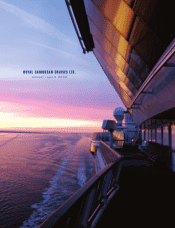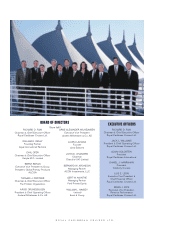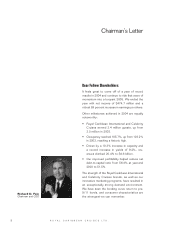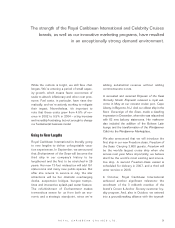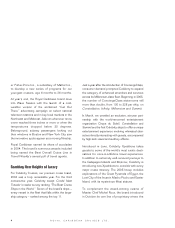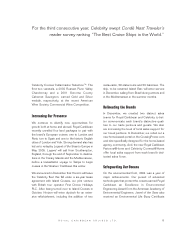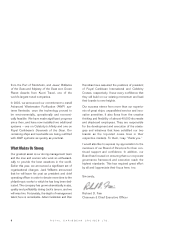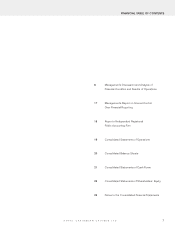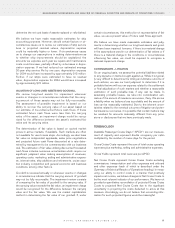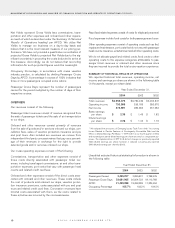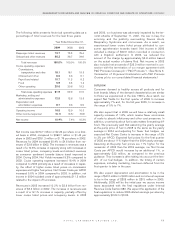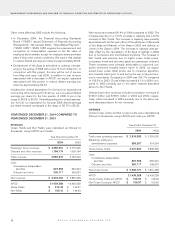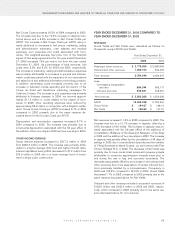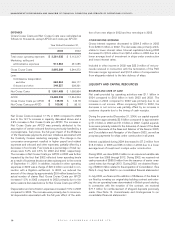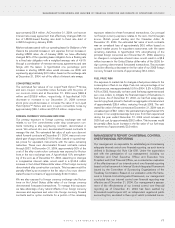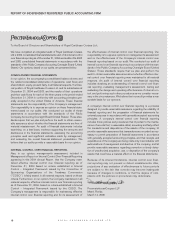Royal Caribbean Cruise Lines 2004 Annual Report Download - page 10
Download and view the complete annual report
Please find page 10 of the 2004 Royal Caribbean Cruise Lines annual report below. You can navigate through the pages in the report by either clicking on the pages listed below, or by using the keyword search tool below to find specific information within the annual report.
As used in this document, the terms “Royal Caribbean,”
“Company,” “we,” “our” and “us” refer to Royal Caribbean
Cruises Ltd., the term “Celebrity” refers to Celebrity Cruise
Lines Inc. and the terms “Royal Caribbean International” and
“Celebrity Cruises” refer to our two cruise brands. In accordance
with cruise vacation industry practice, the term “berths” is deter-
mined based on double occupancy per cabin even though
many cabins can accommodate three or more passengers.
Certain statements under this caption “Management’s
Discussion and Analysis of Financial Condition and Results of
Operations,” in our letter to shareholders and elsewhere in this
document constitute forward-looking statements under the
Private Securities Litigation Reform Act of 1995. Words such
as “expect,” “anticipate,” “goal,” “project,” “plan,” “believe,”
“seek,” and similar expressions are intended to identify these
forward-looking statements. Forward-looking statements do not
guarantee future performance and may involve risks, uncertain-
ties and other factors which could cause our actual results, per-
formance or achievements to differ materially from the future
results, performance or achievements expressed or implied in
those forward-looking statements. Examples of these risks,
uncertainties and other factors include, but are not limited to:
•
general economic and business conditions,
•
vacation industry competition, including cruise vacation
industry competition,
•
changes in vacation industry capacity, including over capacity
in the cruise vacation industry,
•
the impact of tax laws and regulations affecting our business
or our principal shareholders,
•
the impact of changes in other laws and regulations affecting
our business,
•
the impact of pending or threatened litigation,
•
the delivery of scheduled new ships,
•
emergency ship repairs,
•
negative incidents involving cruise ships including those
involving the health and safety of passengers,
•
reduced consumer demand for cruises as a result of any number
of reasons, including geo-political and economic uncertainties, the
unavailability of air service, armed conflict, terrorist attacks and the
resulting concerns over safety and security aspects of traveling,
•
our ability to obtain financing on terms that are favorable or
consistent with our expectations,
•
changes in our stock price or principal stockholders,
•
the impact of changes in operating and financing costs,
including changes in foreign currency and interest rates and
fuel, food, payroll, insurance and security costs, and
•
weather.
The examples are not exhaustive and new risks emerge from
time to time. We undertake no obligation to publicly update or
revise any forward-looking statements, whether as a result of
new information, future events or otherwise.
CRITICAL ACCOUNTING POLICIES
Our consolidated financial statements are prepared in accor-
dance with accounting principles generally accepted in the
United States. (See Note 1.
General
and Note 2.
Summary of
Significant Accounting Policies
to our consolidated financial
statements.) Certain of our accounting policies are deemed
“critical,” as they require management’s highest degree of
judgment, estimates and assumptions. We have discussed
these accounting policies and estimates with the audit com-
mittee of our board of directors. We believe our most critical
accounting policies are as follows:
SHIP ACCOUNTING
Our ships represent our most significant assets and are stated
at cost less accumulated depreciation or amortization.
Depreciation of ships, which includes amortization of ships
under capital leases, is computed net of a 15% projected resid-
ual value using the straight-line method over estimated service
lives of primarily 30 years. Improvement costs that we believe
add value to our ships arecapitalized as additions to the ship
and depreciated over the improvements’ estimated useful
lives. The estimated cost and accumulated depreciation of
refurbished or replaced ship components are written-off and
any resulting gain or loss is recognized in cruise operating
expenses. Repairs and maintenance activities are charged to
expense as incurred and drydocking costs are accrued evenly
over the period to the next scheduled drydocking.
Our service life and residual value estimates take into consid-
eration the impact of anticipated technological changes, long-
term cruise and vacation market conditions and historical use-
ful lives of similarly-built ships. In addition, we take into consid-
eration our estimates of the average useful lives of the ships’
major component systems, such as hull, superstructure, main
electric, engines and cabins. Given the verylarge and complex
natureof our ships, our accounting estimates related to ships
and determinations of ship improvement costs to be capitalized
require considerable judgment and are inherently uncertain. We
do not have cost segregation studies performed to specifically
componentize our ship systems; therefore, we estimate the
costs of component systems based principally on general and
technical information known about major ship component sys-
tems and their lives and our knowledge of the cruise vacation
industry. We do not identify and track depreciation by ship
component systems, but instead utilize these estimates to
ROYAL CARIBBEAN CRUISES LTD.
8
MANAGEMENT’S DISCUSSION AND ANALYSIS OF FINANCIAL CONDITION AND RESULTS OF OPERATIONS

